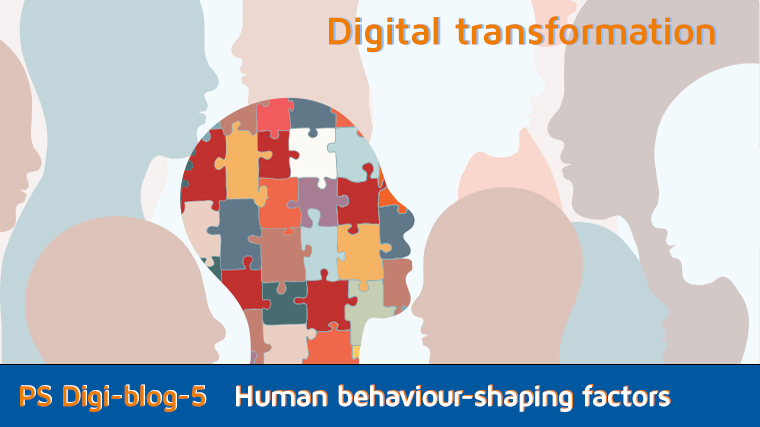
11-09-2023
Hungary
Outsourcing
digitalization, digital transformation, human behaviour, change management, personality traits, supportive leadership, social environment, working environment, Professional Life at PS
Author: István Gyüre
The human challenges of digital transition – Implementation of a new organisational culture
Understanding the factors that shape human behaviour is crucial, because people’s unique behaviour can only be moderately shaped by the tools available in the workplace. Therefore, in establishing and strengthening a new corporate culture during digital transformation, it is advisable to focus on engaging and supporting employees who are already aligned with its (cultural) values.
The ‘recognition’ and involvement of colleagues close to the preferred new organisational core values in supporting digital transition is primarily possible at the team level. The reason is that only the immediate leader has a real chance of deeply understanding a team member and establishing such a trusting relationship with them that allows not only for interpreting their current behaviour, but also for recognising the reasons triggering such behaviour, be it work-related or personal. Therefore, as described in our previous ’digi-blog post’, it is worth considering ‘people as individuals’ and ‘people as employees’ as separate target groups in change management, so that we can take into account not just work-related, but also external factors during change management. [1]
Naturally, it’s impossible to fully understand the behaviour of a ‘person as an individual’ due to the justifiable and legally guaranteed protection of privacy, as well as its extraordinary complexity. We can only get impressions about certain aspects of an employee’s life based on the information they voluntarily share and where they might seek support. Hence, empathic and open communication is an extremely valuable leadership competency, as it helps to establish a mutually trusting and supportive atmosphere. Importantly, this atmosphere of trust is not solely the result of interactions between a leader and a subordinate, but builds upon the positive relational system between the two individuals. As a result, personalised leadership support solutions that emerge from this can synergise in motivating team members and increasing their commitment, thereby likely hastening their adaptation to changes as well.
Main factors shaping behaviour
The formation of human behaviour is influenced by numerous factors, and its complex development are studied across various scientific disciplines, each contributing theories for its understanding. Within the scope of this article, the following categorisation of behavioural factors aims to provide a simple and practical “guide” for leaders to facilitate their adaptation to the key factors shaping the behaviour of their team members. During the preparation for digital transformation, it is worth acquainting middle managers, who play a significant role in change management, with these grouped factors to better understand their effects.
Taking into account behaviour-shaping factors provides an opportunity for leaders who employ ‘supportive leadership’ to manage change more effectively and see results earlier. We will review these below — without aiming for completeness — complemented by some relevant findings and practical examples.
1 Personality traits
People are inherently different, influenced also by their socialisation, which significantly impacts their attitude towards change. For instance:
- Some are open and adventurous, easily adapt, and may not only accept, but initiate changes, becoming active supporters—however, they may take on more risk, be less motivated and less accurate in their current tasks due to their focus on the future.
- Others prefer stability, closer to conservative risk-minimisers who consciously avoid new experiences, and may resist changes with varying behaviours or even excuses. Yet, they may be more reliable and organised in executing current tasks.
It’s worth mentioning that risk-averse behaviour is more prevalent in the financial-accounting service business environment, as this area, given its strong legal regulation, understandably attracts people who are more conservative and sensitive to risk. Therefore, for leaders in the sector, recognizing the real reasons behind the resistance to change among their employees can represent a greater-than-average challenge, and providing appropriate support to match that is important.
2 Age
We all are familiar with age-related trends in change from our personal experiences. Generally, we become more conservative with age and rely more on our established routines to solve our daily tasks.
Why? Because we can easily solve the familiar tasks in the usual way without much effort.
This poses no problem until a disrupting technological change arrives, bringing countless uncertainties—as is the case with digital transformation.
3 Social Environment — Family, friends, and wider social circles
These factors, deeply rooted over time, give cultural basis to our character and behavioural development. They fundamentally influence traits like our flexibility, adventurousness, communication skills, openness, and sense of duty, affecting our adaptability.
Our private life events can also affect our “current” work behaviour. If the leader has established a relationship of trust with the team members, knowing their significant life challenges can facilitate:
- understanding their reactions,
- establishing open communication with them, and
- providing support tailored to their needs,
- potentially by adjusting work organisation within the team.
This empathetic supportive leadership style helps in retaining the commitment of the given employee, which can make them an active supporter of changes, and it also impacts the rest of the team, as they can trust that they will receive appropriate support in similar situations when needed.
This approach fosters a positive, empathetic, change-accepting team spirit, strengthening a flexible, productive work culture at the company level.
4 Work environment
Contrary to what is written in point 3, discreet changes in the work environment generally only have a short-term impact on behaviour of an employee as an individual. For example, motivational opportunities such as:
- tailoring tasks to fit individual skills,
- recognising genuine performance,
- promotions,
- pay raises,
- acknowledgement from clients,
- providing opportunities for growth,
all contribute to maintaining a positive workplace and team atmosphere, which in turn supports adaptation to change.
However, these motivational and appreciative tools that increase employee engagement must be applied consistently, in order to achieve and maintain the desired effect, while aligning with current corporate opportunities and employee needs.
5 Prior professional and life experience
From a change management perspective, it is worth highlighting that professional and life experiences can either strengthen or weaken adaptability to change, depending on the individual’s personality traits (point 1).
Here we will only focus on resistant behaviour. It is a human trait that the more solid our professional and life experiences seem, the more likely we are to rely on stereotypical generalisations, thereby “saving” time and energy for future thinking. If we are not sufficiently confident about meeting future challenges, or if we lack information about the changes, then various forms of “excuse-based behaviours” quickly emerge, such as:
- sceptical attitudes (“It won’t work anyway“),
- strongly critical opinions against new processes (“It’s not good enough this way“), or
- constant dissatisfaction, where “nothing is good” that leads in a new direction.
Managing these can consume a lot of time and energy during the digital transition process, so it’s important to quickly clarify the real reasons and eliminate resistance by addressing them.
Of course, employees who already have a positive, supportive, or active attitude provide some counterbalance against those who resist, but usually, the latter are present in greater numbers.
Because of such examples, it’s important to prepare employees for changes through continuous information sharing, and then involve them in the transformation process, so that at least uncertainty due to lack of information does not result in resistant behaviour.
6 Socio-cultural characteristics
This includes, among others, human interactions, tolerance, social customs, societal roles and norms, providing a framework for social integration. Their formation is significantly influenced by factors in points 3-5.
Due to their strong entrenchment in our character and behaviour, and their complexity, influencing them is only possible in the long term. Therefore, it is necessary to specially involve and support employees who share values compatible with the new company culture during the transformation, as it is almost impossible to change the mindset of employees with significantly different cultural values in the generally short time available.
7 Quality of support received for change
Generally, it can be said that adapting to any significant change in any area and phase of our lives is significantly easier if there is someone who can provide effective support for its understanding and processing, i.e., for adapting to the new situation. This also applies to changes affecting the work environment! The adequacy of managerial support significantly influences behavioural reactions to digital process and technological changes; therefore, ensuring this is a key factor for the human side of digital transformation success. We emphasise that workplace support—usually from middle management—can only be truly effective when harmonised with the factors listed in points 1-6, and customised individually.
The dual focus of supportive leadership: the person as an employee and as an individual
Understanding the factors that shape behaviour allows leaders to analyse their team members’ actions from two perspectives and support them in solving their challenges. Although the focus at work is on the “person as an employee”, ongoing consideration must be given to information about the “person as an individual” to uncover the precise and genuine reasons for resistance to change. This makes it possible to transform resistant team members into supporters who understand and appreciate the benefits of change.
It’s important to note that people, as individuals, have unique qualities that, combined with characteristics stemming from their employee status, define their relationship to work and, consequently, their attitude towards tasks and changes. For example, behavioural elements that contribute to individual diversity—like openness, sociability, emotional stability, conscientiousness, and life purpose—underpin key workplace qualities such as motivation, expected flexibility in teamwork, and the relationship to work that is fundamental for career development.
Here, it’s important to mention three essential expectations that any success-seeking employee cannot ignore and should not expect from their employer: personal accountability, commitment, and ambition for their own ongoing development, as well as a constant striving for openness, a positive attitude, and emotional stability.
The development of personal accountability and commitment is largely tied to one’s upbringing and cultural background. The role of the workplace can “only” be to provide the necessary framework and environment. In adapting to digital transformation, the employer provides the “necessary conditions” (developmental environment, tools, support…), but the “human conditions” for realisation must primarily be ensured by the employee as an individual through their own persistence and ambition.
Summary thoughts, expanding on the above…
Digital transformation and the hybrid work system widespread during the Covid-19 pandemic in recent years have imposed a revolutionary scale and degree of “forced change” on companies. Continuous changes deeply affect every level of an organisation and operation. Whether it’s an experienced leader or a newcomer, these developments that fundamentally reorganise our daily routines at work—and even in private life—almost inevitably trigger a wide range of responses and behaviours, often as resistance.
Therefore, during the strategic planning phase, company management must anticipate the need to provide full support to key players in change management so that they can become capable—within their own scope of influence and responsibility—of supporting every team member at the right time, with the right knowledge and methods, so that they eventually become active supporters and beneficiaries of digital changes.
The company that can achieve this will be among the winners of the digital transformation revolution, significantly enhancing its competitiveness.
References:
[1] Digi-blog-4: Digital transformation – Human aspect challenges and key target groups of change management
(A cikk olvasható magyarul is a PS HU karrieroldalán >>)
Our former Digi-Blog posts about digital transformation:
4 – Digital transformation – Human aspect challenges and key target groups of change management
3 – Change management and its cultural aspects in the digitalisation of accounting
2 – 5 Key goals for digital transformation in professional business services
1 – Digitalization – The engine of economic growth in the 21st century
Browse and read our previous blog posts here.
Follow us on LinkedIn!

